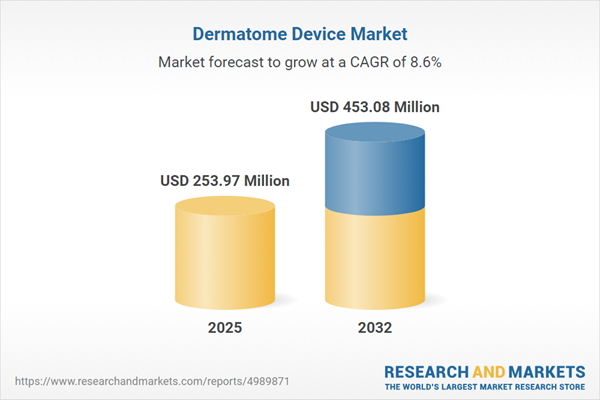Speak directly to the analyst to clarify any post sales queries you may have.
The dermatome device market is evolving rapidly, shaped by technological advancements and shifting regulatory landscapes. As healthcare providers seek higher efficiency and improved patient outcomes, decision-makers require clear, actionable insights to inform procurement and growth strategies.
Market Snapshot: Dermatome Device Market Growth and Trends
This report provides a comprehensive analysis of the dermatome device market’s recent expansion. The market has demonstrated robust growth, progressing from USD 234.17 million in 2024 to USD 253.97 million in 2025, with expectations to maintain an 8.60% CAGR through 2032 and reach USD 453.08 million. Demand is propelled by the adoption of precision-driven surgical tools, growing focus on outpatient procedures, and enhanced clinical safety measures. The report examines how digital integration and product innovation are influencing buying decisions in the context of global healthcare shifts.
Scope & Segmentation: Dermatome Device Market Overview
This analysis covers all core market segments and technology categories critical to senior leaders’ strategic planning:
- Application Settings: Ambulatory surgical centers, hospitals, and specialty clinics are assessed for demand patterns and operational priorities.
- Device Types: Includes electric (benchtop and portable), manual, microprocessor-controlled, and pneumatic dermatome systems, each serving distinct clinical environments.
- Usage Modes: Reviews disposable, reusable non-sterilizable, and sterilizable options, addressing considerations related to lifecycle cost and infection control.
- Geographic Regions: Americas (North America, Latin America), Europe, Middle East & Africa (with country-level breakdowns), and Asia-Pacific, reflecting localized trends and funding models.
- Leading Companies: Profiles Zimmer Biomet Holdings, B. Braun Melsungen, Integra LifeSciences, Medzer LLC, Robbins Instruments, 3M Company, SPINCO, ConMed Corporation, Medtronic plc, and Technomed Private Limited. Strategic initiatives, partnerships, and innovations are analyzed across these industry participants.
Key Takeaways: Strategic Insights for Senior Decision-Makers
- Accelerated advancements in automation, material science, and safety features are reshaping the expectations of clinical teams regarding dermatome device functionality and precision.
- Regulatory standardization across major markets requires manufacturers to invest in compliance infrastructure, elevating the importance of traceability, sterility, and biocompatibility in the product development cycle.
- Shift toward minimally invasive procedures and shorter post-surgical recovery times is increasing demand for portable, ergonomically designed devices in the outpatient setting.
- Real-time digital integration and sensor-enabled feedback are enhancing reproducibility of outcomes and enabling data-driven clinical decisions.
- Targeted design for infection mitigation, including single-use and easy-sterilization features, is gaining priority amid broader infection control mandates.
- Strategic partnerships between device developers, digital health firms, and educational entities are expanding the clinical footprint and post-market support of innovative dermatome solutions.
Tariff Impact: 2025 US Policy Shifts
New tariff regulations in the United States are causing manufacturers to reevaluate sourcing strategies and operational costs. Adjustments include renegotiating supplier contracts, investing in domestic manufacturing, and enhancing supply chain resilience. These proactive responses are designed to manage raw material expenses, maintain competitive product pricing, and secure production continuity despite cost pressures.
Methodology & Data Sources
Research combines in-depth interviews with clinical experts and procurement leaders, supplemented by structured quantitative surveys. Secondary data is gathered from regulatory filings, published literature, device approval databases, and open-access government resources. Data triangulation and expert review ensure analytical robustness and accuracy.
Why This Report Matters
- Enables decision-makers to align their device portfolio strategies with evolving clinical and regulatory priorities for dermatome technology.
- Identifies emerging opportunities across differentiated care settings, guiding efficient investment and procurement planning to support clinical adoption and growth.
Conclusion
The dermatome device market is in a period of innovation and adaptation as digital integration and stricter standards become the norm. Leaders who anticipate operational, regulatory, and technology shifts will be best positioned for sustained market advantage and success.
Additional Product Information:
- Purchase of this report includes 1 year online access with quarterly updates.
- This report can be updated on request. Please contact our Customer Experience team using the Ask a Question widget on our website.
Table of Contents
3. Executive Summary
4. Market Overview
7. Cumulative Impact of Artificial Intelligence 2025
Companies Mentioned
The companies profiled in this Dermatome Device market report include:- Zimmer Biomet Holdings, Inc.
- B. Braun Melsungen AG
- Integra LifeSciences Holdings Corporation
- Medzer LLC
- Robbins Instruments
- 3M Company
- SPINCO
- ConMed Corporation
- Medtronic plc
- Technomed Private Limited
Table Information
| Report Attribute | Details |
|---|---|
| No. of Pages | 180 |
| Published | October 2025 |
| Forecast Period | 2025 - 2032 |
| Estimated Market Value ( USD | $ 253.97 Million |
| Forecasted Market Value ( USD | $ 453.08 Million |
| Compound Annual Growth Rate | 8.6% |
| Regions Covered | Global |
| No. of Companies Mentioned | 11 |









